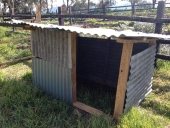John Malayter wrote:We as farmers don't have expendable income to put in a large facility to farrow and raise these animals so are their any ideas on how to up my number of animals and keep my facility sustainable and cheap to build.
Keep your infrastructure costs as low as you can. Barns are not really necessary. We're in Vermont which is a much colder climate and we've kept pigs outdoors year round for twelve years. We have about 400 pigs with about sixty breeders running in multiple boar centric herds. They live, breed and farrow on pasture using about 70 acres with managed rotational grazing. Primarily at any time we're using about 40 acres that rotates year to year over the 70 acres (larger area for future expansion) with a central ten acres that is used each year with shorter rests. In the winter we pull the pigs into the central most five to ten acres as the snow pack develops for winter paddocks where we have deep bedding packs that
compost to generate heat in open sheds and an open greenhouse. Our biggest infrastructure is the fencing followed by water setup and then the simple open sheds. Cheap. Simple.
John Malayter wrote:Ps. I have access to a lot of woods on our property........
Woods is not very rich in food value. Seasonally it may have some things like acorns if you're lucky but not much most of the time. Our pastures are a mix of woods, brush and open ground forages. Think savanna style.
In our pastures we plant:
soft grasses (bluegrass, rye, timothy, wheat, etc);
legumes (alfalfa, clovers, trefoil,vetch, ect);
brassicas (kale, broccoli, turnips, etc);
millets;
amaranth;
chicory; and
other forages and herbs.
Exactly what varieties will depend on your local climate and soils. I avoid the grasses and such that turn toxic with drought, frost or other stress as they make our management system too complex.
I prefer perennials or things that self-reseed. Some things labeled as annuals are actually perennials in our climate because we get early snows that protect their roots over the winter - e.g., kale, broccoli, etc.
In our winter paddocks we plant during the warm months things like pumpkins, sunflowers, sunchokes, beets, mangels, sugar beets, etc. These become fall and winter food for the livestock.
Seed companies we buy from include: Johnny's, Hancock, High Mow, Bakers and a couple of others I'm not thinking of at the moment.
Planting up your pasture to things the pigs can easily digest, to orchards, to easy crops that fit your skills all helps.
John Malayter wrote:My goal? I'd like to farrow 1 pig per month
A good plan. So that would be 12 farrowings per year. If two per sow per year that would be six sows which is the bare minimum justify a boar in many setups. I figure that to justify the cost of a boar it takes three sows if by land (pastured) and six if by seed (feeding grain). Figure eight piglets per litter weaned and you've got about 100 finished pigs per year or about 8 pigs sold per month.
John Malayter wrote:giving me 8-16 piglets per birth
Optimism is always good in farming.

John Malayter wrote:I'd keep as many piglets as possible for 6-8 months up until processing.....if this makes any sense! I would then have enough pigs on the ground at any given time to satisfy my customers.
Do a business model and spreadsheet to see how the numbers run. Then remember that these things are not even as good as the assumptions and reality is always different. Life happens. Deadstock is.
John Malayter wrote:Now I don't want to confine these animals however ther will home confinement with these number, strictly for farrow, gestation etc.
We do it all without confinement - all out on pasture - and in a much colder climate. We still have snow on the ground April 25th. Snows start in October or November. I think in Tennessee it should be much easier as long as you set things to drain and stay dry through mud season.
John Malayter wrote:let's say I have 8 pigs ( on the low side) per month per sow, after 6-8 weeks these get weened and the sow go's back to the pasture and the babies get moved to where they cannot see mamma, next month new sow and new babies, six weeks those babies get moved with this other littleuns and so on. ... The only thing that bothers me is keeping them cooped up for the 6 weeks but those babies are such a pain in the a$$ and get into everything so its probably not bad to train them to a hot wire while they're confined.
At weaning we send weaner pigs to tightly fenced weaning paddocks that rotate them through a system that trains them to all the different types of fencing we use on our farm, keeps them distantly separated from the sows who go a different direction to dry and rebreed. During the weaning time we do taming of the weaner piglets and track them to roaster, finisher and breeder tracks. All of this is out on pasture, not confinement buildings so they're in a healthy sustainable environment that is low cost infrastructure. We use managed rotational grazing - key. See the training system here:
http://sugarmtnfarm.com/2013/09/25/south-weaner-paddock/
-Walter



































 2
2










